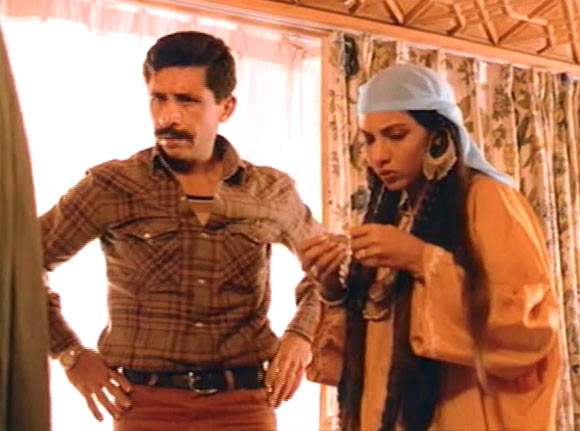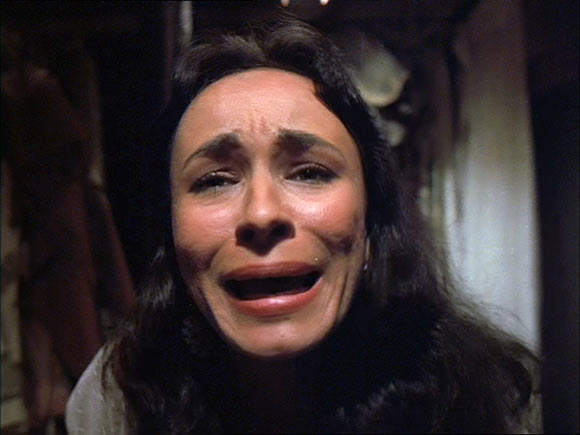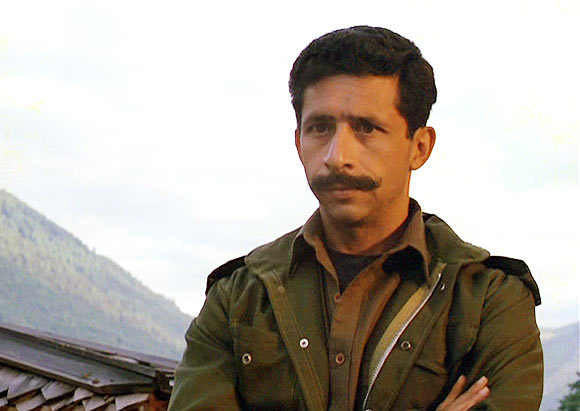This article was first published 12 years ago
Home »
Movies » Khamosh: Revisiting Vidhu Vinod Chopra's brilliant whodunit
Khamosh: Revisiting Vidhu Vinod Chopra's brilliant whodunit
Last updated on: June 6, 2013 19:13 IST
Image: Naseeruddin Shah and Shabana Azmi in Khamosh
In our special series re-visiting great Hindi film classics, we look back at Shabana Azmi, Amol Palekar, Pankaj Kapur, and Naseeruddin Shah starrer Khamosh (1985). A certain enigma builds around films you (desire to but) do not get to see as a kid.
Like I wasn't even born when Jaani Dushman came out. Years later, in the days of cable TV-free existence, my nanny recounted the entire screenplay to me verbatim in the manner of fairy tales.
A fine narrator, her description and revelations left me enraptured, terrified and startled. Without actually seeing the film, I decided it's the scariest film I've ever seen. Of course, when I finally did watch it, I found the whole 'beast man blood thirsty for bride in red' extremely amusing.
Later in 1985, when Mandakini made news for her famous waterfall scene in Ram Teri Ganga Maili Ho Gayi, Amitabh Bachchan doodled 'Mard' on his chest and Sunny Deol made new fans with his commanding presence in and as Arjun, also released Vidhu Vinod Chopra's small-budget whodunit Khamosh featuring some of the best actors we've ever had -- Amol Palekar, Shabana Azmi, Naseeruddin Shah and Pankaj Kapur.
I was much too young to care. But I do remember how my mom who saw it with her colleagues and my brother who sneaked out with his cronies, raved endlessly about the unexpected killer and its unique treatment. That's the part when I feel both -- left out and lucky.
There's no need to explain the former but the latter since I didn't pay any attention to the murderer's identity and avoided all spoilers for more than two decades till I finally saw it.
And my first-reaction is disbelief at just how overlooked this brilliant piece of filmmaking is.
P:S: If you haven't seen it already, be warned, spoilers ahead.
Image: Shabana Azmi and Amol Palekar in Khamosh
There's a tendency to patronise the suspense genre instead of extending it the same reverence one would to a literary adaptation, period piece or social drama.
If I cannot change the general perception, I will certainly not contribute to it.
What is extraordinary about Khamosh is just how multi-textured it is. Chopra's second feature film, following Sazaaye Maut, works as a thriller but it's also a pungent commentary on how the film industry operates -- the darkness behind its dazzle, its deep-rooted chauvinism and its sleazy, exploitative mentality.
There's also an element of style in his approach.
Made at a budget of Rs 8 lakh, Chopra may not have the finance to fashion a lavishly mounted movie-within-movie scenario but he comes up with many ingenious ideas to marginalise production-related limitations.
So you have actors playing themselves -- Amol Palekar is Amol Palekar and Shabana Azmi as (three-time National Award winner who went on to win two more) Shabana Azmi.
And the movie they're filming around the picturesque locations in Kashmir is forebodingly titled Aakhri Khoon.
Before Khamosh slips into a full-bodied murder mystery, Binod Pradhan's eagle-eyed cinematography (one of the best use of red filters ever) establishes it multiple characters, predominantly members of the film unit (with the likes of Pavan Malhotra, Sudhir Mishra, Deepak Qazir, Uday Chandra, Virendra Saxena and Naseeruddin Shah (he did the stills) moonlighting as cast AND crew).
Image: Soni Razdan in Khamosh
Pradhan's camera zooms in and out slyly lending a sense of suspicion around every prop while Ranjit Kapoor's telling dialogues disclose the personality of its protagonists -- an ambitious mother (Sushma Seth) lobbying to get her young, naive daughter a meaty role under a producer (Ajit Vachani) she's 'close' to, the concerned producer plays the casting couch card to the hilt, the object of his as well his spaced out, dopehead kid brother's (Pankaj Kapur) affection (Soni Razdan) refuses to 'cooperate' and wants to be recognised as more than a pretty face, a cinematographer (Sudhir Mishra looking like a rockstar with his statement beard) who deviously suggests the significance of keeping the lens man happy, a leading lady (Azmi) with sleepwalking issues, a leading man (Palekar) pursuing the chief minister's post in politics, a sneering writer (Virendra Saxena) with an ugly sense of humour and a passionate director (Sadashiv Amrapurkar) who wants to complete his movie at any cost.
They're all in Pahalgam, a touristy destination of Jammu and Kashmir, to film a formulaic masala potboiler, typical of the 1980s, with Palekar scowling the usual 'Khoon pee jaonga' and Azmi sniffling on cue to incessantly harp the same old, 'Woh bechari uske bachhe ki maa banne wali hai.'
Only Chopra's brand of parody brims with believability -- the obvious itself is absurd, there's hardly any need to exaggerate. He sticks to this blend of satirical realism in the off-screen scenes as well.
That's why the casualness with which Amrapurkar improvises -- altering a suicide scene into a murder -- on the spur of the moment hits hard.
This is largely how things worked in a decade when bound scripts were unheard of and stars simply showed up and did as the director ordered.
The relevance in Vachani's cold, detached resolution, 'Kal ka din mourning manayenge, parson se shooting chaalu kar dijiye,' subscribing to the show must go on diktat continues to hold true even today.
Equally disturbing is the scene which depicts how an aspiring actress is taken advantage of under the pretext of a rape scene and the vicarious pleasure filmmakers derive in prolonging her misery. The visual itself concentrates on the vile smiles of the visibly titillated unit but the upshot is most harrowing.
Image: A scene from Khamosh
Khamosh is a series of one inspiring scene after another.
Right from the first murder in a creepy, claustrophobic costume closet of a boat house where Soni Razdan is rehearsing a scene wherein she's, ironically, protesting over her murder. The venue, as it turns out, is the murderer's choice for the second execution as well as the remarkable climax in the end.
At a celebration to mark the completion of VVC Films' 30 years, Chopra revealed the costume space was actually a terribly tiny area where they used extreme wide angled and colours to render it a spacious feel.
It's also impressive how Chopra succeeds in keeping the unit so isolated from mainstream by cleverly planting hurdles that cannot be escaped immediately. Situations within the script build themselves in a manner that prevents the film unit from getting back to normal.
Image: Shabana Azmi in Khamosh
That doesn't mean Khamosh is devoid of the signature structure that is part and parcel of this genre -- there's palpable tension, a couple of exciting red herrings and a delicious tribute to Psycho.
That one shot of the iconic shower scene from Hitchcock's classic playing out in a bare hotel room lingers on as much as the moment of big reveal against a soaked window when shock meets fear. Superlative stuff, this.
Sporting a look (a stern moustache and black sunglasses) likely to remind you of J P Dutta's Ghulami, which also released that year, Naseeruddin Shah makes his entry at a crucial stage.
What is perceived as an open-shut case of suicide finds evidence of murder, a claim that is substantiated with subsequent killings.
Chopra, who previously worked with Shah (along with Pankaj Kapur and Deepak Qazir) on Jaane Bhi Do Yaaron, unfolds his character like a piece of the puzzle and not just someone out to solve it.
But when he conducts his investigations and searches every single hotel room, Chopra cuts back and forth to the room and its inhabitant, examining curious traces of concealed secrets and possible motives.
These carefully thought out intricacies contribute in making the songless Khamosh a case of exemplary filmmaking.
There's no place for romantic angles, poetic flirtations, lilting music, Kashmir darshan, no pleasantry whatsoever in his crisply-edited (by then wife Renu Saluja to whom he dedicates the film along with Mangesh Desai) vision of a stark script.
Instead Vanraj Bhatia's ominous background score, assisted by Dadasaheb Phalke recipient Kersi Lord and composer Uttam Singh (Dil To Pagal Hai, Dushman), is designed to suit the temperament of dread and anticipation.
Image: Naseeruddin Shah in Khamosh
Khamosh leaves out the popular excesses but there's nothing scant about its imagination or populated frames.
Considering its cast is a sprawling unit, it's quite a challenge to utilise all of them adequately. To Chopra's credit, he doesn't let anyone go waste.
Shabana Azmi's honed skills and effortless warmth in a role that demands her to scream a whole lot frequently, Naseer Shah's restrained dynamism even when he scarcely opens his mouth, Pankaj Kapur's nervous energy and eerie gaze that marvellously attracts (and distracts) and there's also Soni Razdan in traditional Kashmiri attire reminding you just how much her daughter Alia Bhatt resembles her mother.
Irrespective of the role's length or designation, the key players, the supporting cast, half a dozen props and the all-encompassing Pahalgam Hotel collaborate like a combined team effort to elevate the delicately laid-out deceit. In any tale of intrigue, the climax (or the killer if you please?) is the deal breaker.
Right from the breathtaking chase in the town streets where you learn why the one you thought is the killer is not the killer -- the clever bullets theory -- till the original offender meets his end, Chopra's third act offers a befitting finish and a joyride in nail-biting entertainment.
I haven't forgotten Amol Palekar who simply walks away with Khamosh in the chilling final scene. His icy cool demeanour as he tenderly discloses his intention to bump off his last victim is a far cry from the self-conscious, bumbling office goer roles he's best known for. His motivation to kill may seem a little less sensational in 2013 but the criminal fervour of his manic, enlarged eyes is disconcertingly effective.
At the end, a disclaimer shows up saying All characters in this film are fictitious. Palekar later joked about how the original write-up read, 'Amol Palekar is not a murderer and Shabana Azmi does not sleepwalk.'





